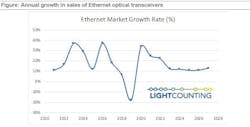Growth rate for Ethernet transceivers expected to remain in double digits: LightCounting
After growing 32% in 2020 and setting a revenue record in 2021, sales of Ethernet optical transceivers will continue on an overall steady double-digit growth pace for the next five years, LightCounting predicts. The market should see a compound annual growth rate (CAGR) of 14% from 2022 to 2027, despite occasional volatility, the market research firm states in its newly released High-Speed Ethernet Optics Report.
Ethernet optical transceiver sales hit $4.6 billion in 2021, an increase of 25% from 2020. An unexpected increase in demand for legacy products got the year off to a good start, according to LightCounting. Interest in 200 Gigabit Ethernet (GbE) and 400GbE modules among hyperscale operators picked up the market from there, with Google also making initial deployments of 2x400GbE transceivers.
LightCounting expects sales of such high-speed modules to keep sales growth percolating this year before the market settles into the 14% CAGR over the rest of the forecast period. The time period will see the advent of 800G and even 1.6T devices; LightCounting says it increased its forecasts for such modules in the latest report. Should the 14% CAGR come to pass, the Ethernet optical transceiver space will be worth $10 billion by 2027, the market research firm states.
LightCouting’s new High-Speed Ethernet Optics Report provides analysis on the factors driving the market for Ethernet optical transceivers with a focus on the high-speed modules used in data centers. It leverages extensive historical data on shipments of Ethernet modules combined with market analyst research to make projections for sales of these products in 2022-2027. The report covers more than 50 product categories, including 1GbE, 10GbE, 25GbE, 40GbE, 50GbE, 100GbE, 200GbE, 2x200GbE, 400GbE, 800G, and 1.6T transceivers, sorted by reach and form factors. It also summarizes the technical challenges faced by high-speed transceiver suppliers, including a review of the latest products and technologies introduced by leading suppliers.
For related articles, visit the Business Topic Center.
For more information on optical modules and suppliers, visit the Lightwave Buyer’s Guide.
To stay abreast of fiber network deployments, subscribe to Lightwave’s Service Providers and Datacom/Data Center newsletters.
About the Author

Stephen Hardy
Editorial Director and Associate Publisher, Lightwave
Stephen Hardy is editorial director and associate publisher of Lightwave and Broadband Technology Report, part of the Lighting & Technology Group at Endeavor Business Media. Stephen is responsible for establishing and executing editorial strategy across the both brands’ websites, email newsletters, events, and other information products. He has covered the fiber-optics space for more than 20 years, and communications and technology for more than 35 years. During his tenure, Lightwave has received awards from Folio: and the American Society of Business Press Editors (ASBPE) for editorial excellence. Prior to joining Lightwave in 1997, Stephen worked for Telecommunications magazine and the Journal of Electronic Defense.
Stephen has moderated panels at numerous events, including the Optica Executive Forum, ECOC, and SCTE Cable-Tec Expo. He also is program director for the Lightwave Innovation Reviews and the Diamond Technology Reviews.
He has written numerous articles in all aspects of optical communications and fiber-optic networks, including fiber to the home (FTTH), PON, optical components, DWDM, fiber cables, packet optical transport, optical transceivers, lasers, fiber optic testing, and more.
You can connect with Stephen on LinkedIn as well as Twitter.
